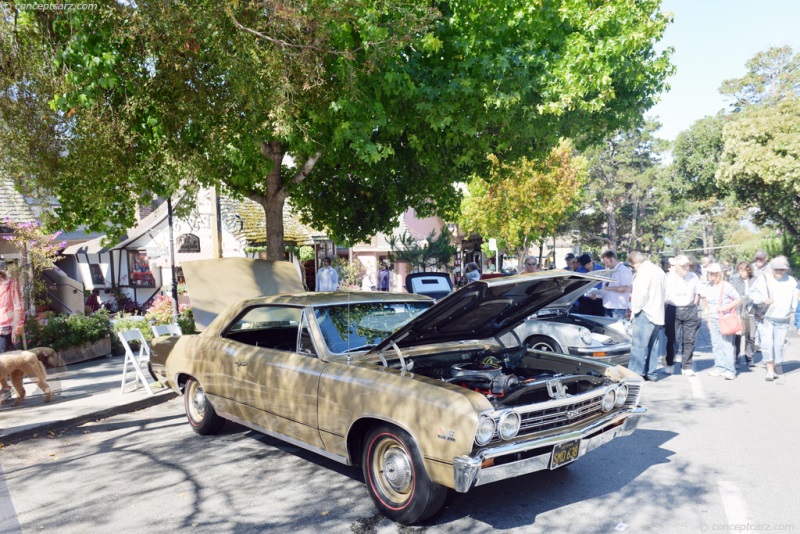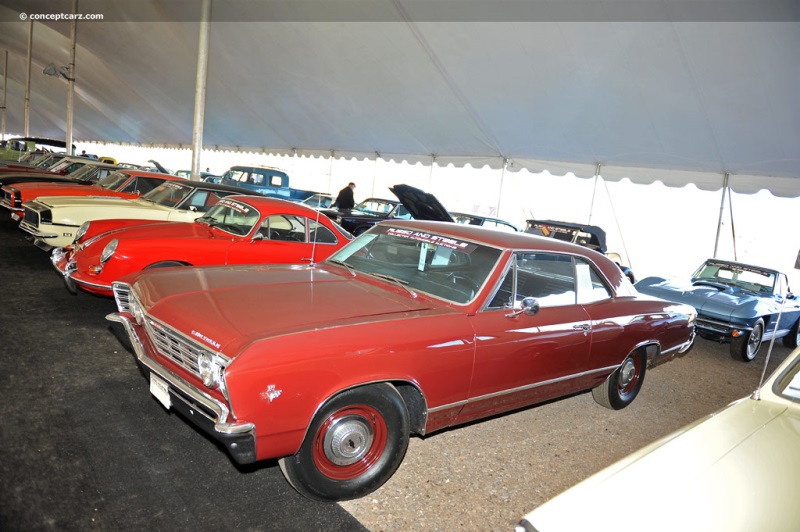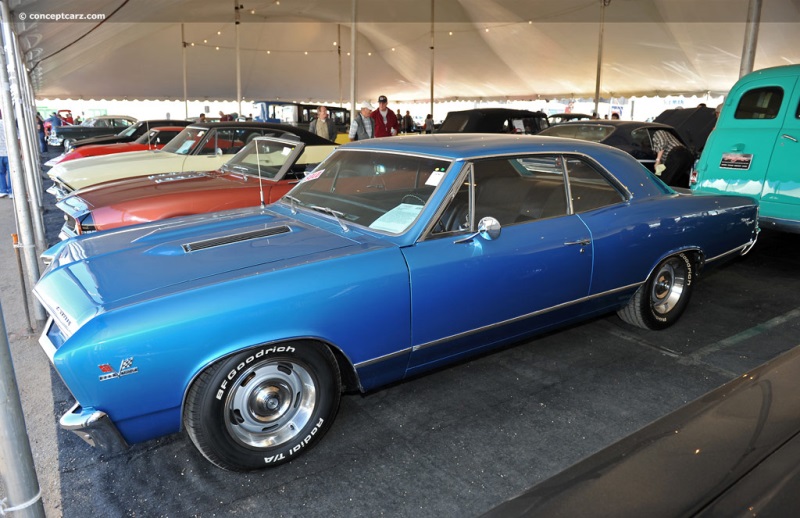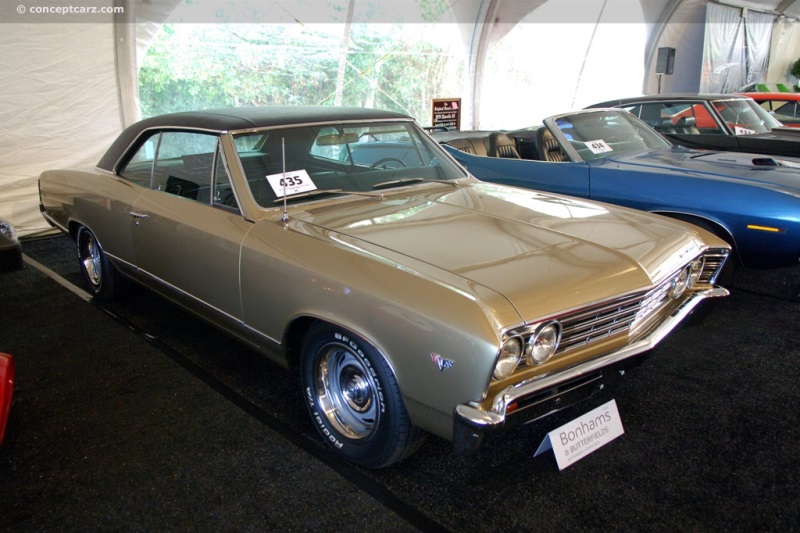From its landmark introduction for 1964, Chevrolets A-Body intermediate Chevelle lineup was very successful on showroom floors and the drag strip. Buyers were drawn to its size, crisp and attractive styling, vast options list, and affordability. The Chevelle's performance reputation grew to new heights with the introduction of the Mark IV big-block engine in 1965 and the limited-production Z-16 option. 
300 Series 31 6 Cyl Sedan
Chassis #: 136177Z129554
Engine #: V0215DJ
View info and history
Auction entries : 2The first generation of Chevelle styling began in 1964 and continued through 1967, using a perimeter frame with a 115-inch wheelbase, a width of 74.6-inches, and an overall length of 197-inches. The Chevelle holds the distinction of being the only all-new car for the 1964 United States model year, and its size and price-point positioned it above the Chevy II and below the full-sized Chevrolet models. Initially, the Chevelle was conceived as a more upscale version of the Chevy II with a unibody platform. Instead, it became part of the General Motors (GM) A-body 'senior compact' platform with body-on-frame construction with a suspension setup similar to its full-sized siblings. The rear used a four-link setup with the differential using four control arms attached to the frame with rear coil springs positioned between the spring pocket and the differential. Power steering, power brakes, a heavy-duty clutch, and a Powerglide transmission were optional. By the time the '1st Gen' Chevelle production ended in 1967, seven transmission options were available, including two manual three-speeds, two manual four-speeds, two automatics, and an overdrive three-speed. The Turbo Hydra-Matic transmission had a manual-shift feature. Chevelle production was handled by plants in Kansas City, Baltimore, and a new facility in Fremont, California. The Chevelle wore styling similar to its Chevy II sibling, with squared body lines, but with curved side window glass and larger overall dimensions. (The Chevy II had a 110-inch wheelbase, a width of 69.9 inches, and a length of 182.9-inches). For 1964, the Chevelle trim levels included the Series 300 offered as a two- and four-door sedan, and two- and four-door station wagon with prices that ranged from $2,230 to $2,530 with six-cylinder power. The base eight-cylinder engine increased the price by approximately $90. The Chevelle Malibu Series, priced from $2,350 to $2,745, was offered as a sport coupe, convertible, sedan, and the two- and four-door station wagon. The standard six-cylinder engine had overhead valves, a cast-iron block, a 194.4 cubic-inch displacement, seven main bearings, a Rochester one-barrel carburetor, hydraulic valve lifters, and developed 120 horsepower at 4,400 RPM. The base eight-cylinder option had a 283 cubic-inch displacement, four main bearings, hydraulic valve lifters, a one-barrel Rochester carburetor, and offered 195 horsepower at 4,800 RPM. A 230 CID six and several V8 engines were optional. 
Malibu Series 36 V8 Sport Coupe
Chassis #: 136177B105633
View info and historyThe convertible, two-door hardtop coupe, four-door station wagons, and four-door sedans were staples of the Chevelle line through its entire production lifespan. Four-door hardtops, also known as Sport Sedans, were available from 1966 through 1972. The two-door station wagon and two-door sedan were available only in 1964 and 1965 on the base 300 series. The El Camino was a derivative of the two-door wagon. Chevelle Super Sport
For 1966 the Chevelles performance-oriented Super Sport moved from being an options package to a series of its own (subseries 138), available with 396 cubic-inch big-block engine. The 'SS' had been part of the Chevelle since the beginning and represented Chevrolet's entry into the muscle car arena. Early 1964 and 1965 Chevelle Malibu SS models wore Malibu SS badging on its rear quarter panel. The Super Sport package added an additional $162 to the price of the upscale Malibu two-door hardtop and convertible body styles. It added 14-inch full-disc wheel covers, SS emblems, additional exterior trim and brightwork, vinyl bucket-seat interior, and a floor console when the optional Muncie aluminum four-speed manual or Powerglide two-speed automatic was selected in place of the standard three-speed manual. The 1966 SS396 was based on the top-line Chevelle Malibu hardtop and convertible and successfully combined neatly sculpted 'Coke Bottle' bodylines with Super Sport appearance features, resulting in one of the most desirable muscle car designs from Chevrolet of the 1960s. The SS396 series continued for 1967, gaining a mild restyling and refinements to the SS appearance package but still offered solely with big-block power. It came with a black-accented grille and blacked-out rear cove panel, special stripes, badges, simulated scoops on the domed bonnet (hood), special wheel trims, and red-stripe tires. The interiors were trimmed in vinyl with optional bucket seats, an SS-badged steering wheel for the first time, a relocated 7,000 RPM tachometer, and a black-accented instrument panel. Factory brochures officially listing just two power levels ranging from the L35 V-8 with 325 horsepower to the L34 with 350 rated horsepower, 10 fewer than in 1966. The 375 horsepower L78 V8 was not officially included in the 1967 Chevrolet marketing material, remaining as a little-known dealer-installed option with estimates placing the number of Chevelles so equipped at just over 600 units. Its 396 cubic-inch displacement was the same that powered the 1965 Corvette, however, the L78 listed at 375 horsepower while the Corvette was rated at 425 hp.
Malibu Series 36 V8 Sport Coupe
View info and historyFor 1967, the Chevelle SS-396 had a base price of $2,825 for the hardtop coupe and 3,030 for the convertible. The combined production total of the SS-396 was approximately 63,006 units with as many as 29,937 of those being convertibles. 1967 SS396 sales were nearly 10,000 less than the 72,272 units produced a year earlier.The styling and bodywork for GM's 'A' body models were restyled for 1966, with smoother contours and reprofiling of the front and rear fenders. There were minor changes to the bumper, curved side windows, bulging rear fender lines, revised turn signals, and a broad new anodized aluminum grille. Its 'Coke bottle' body shape incorporated a 'flying buttress' roofline for the hardtops, forward-slanting front fenders, rear body cove treatment, and the grille flanked by dual round headlamps on either side in anodized aluminum bezels. 1967 Chevelle 300
A mild facelift followed for 1967 as Chevrolet designers and engineers prepared for an all-new generation of bodywork for 1968. The rear end styling was updated with large wraparound taillamps with standard backup lights. The anodized aluminum grille wore a slightly new design with horizontal bars that came to a point in the center. A Chevrolet badge was incorporated into the driver's-side of the grille, series identification was placed on the rear fenders, and Chevelle lettering was on the deck cove. Brightwork surrounded the windshields and ventipane frames.
SS 396 Series 38 V8 Sport Coupe
View info and historyThe interiors were trimmed in cloth and vinyl and had foam-cushioned front seats, lever-type door handles, front door armrests, black rubber floor covering, padded sun visors, glove compartment lock, cigarette lighter, center dome light, four-way hazard flasher system, and parking brake and brake system warning light. The Chevelle 300 Series included a two-door sedan priced at $2,220 and a sedan at $2,250. Approximately 24,700 of the Chevelle 300 were built for 1967, a slight decrease from the circa-28,600 units built the previous year. Most were equipped with the standard six-cylinder engine while around 4,800 buyers selected the standard V8. The standard six was a 230 CID unit with 8.5:1 compression, hydraulic valve lifters, a one-barrel carburetor, seven main bearings, and developed 140 horsepower at 4,400 RPM. The standard V8 had a 263 displacement size, a cast-iron block, overhead valves, a Rochester two-barrel carburetor, hydraulic valve lifters, and developed nearly 200 horsepower at 4,800 RPM. 1967 Chevelle 300 Deluxe
The Chevelle 300 Deluxe included the same body styles as the base 300 Series, plus a station wagon priced at $2,620. The sedan listed for $2,325 and the two-door sedan at nearly $2,300. The Deluxe was slightly more popular than its 300 Series sibling, with approximately 26,300 units built, less than the 37,500 examples of the 300 Deluxes produced a year earlier. There were slightly fewer Deluxes equipped with the six-cylinder engine compared to the base 300 (approximately 19,300 sixes of the Deluxe vs 19,900 of the 300). The Deluxes received additional exterior brightwork included rear cove lower-trim moldings on the sedan and body sill moldings. 300 Deluxe badging was placed on the rear fender and an emblem was positioned in the center of the tailgate. The interiors were trimmed in cloth and vinyl on the two- and four-door sedan body styles while the station wagons were all-vinyl. The instrument panel had a silver-finished upper accent, color-keyed vinyl-coated rubber floor mats, automatic interior light switches on the door jambs, and rear armrests with built-in ashtrays.1967 Chevelle Malibu
The top-of-the-line Malibu was a subseries of the mid-sized Chevelle from 1964 to 1972, and for 1967 body styles included the same list as the 300 Deluxe plus a convertible and four-door station wagon. They were distinguished from the lower Chevelle trim levels by a more lavish interior, additional exterior brightwork, and Malibu badging on the rear fender. Exterior brightwork was added to the lower bodyside, rear quarter moldings, roof drip cap moldings, and rear quarter window reveal moldings on station wagons. The wagons also had a Chevelle badge on the tailgate or rear cove, and a tailgate molding. There were full wheel covers, a black-accented rear cove outline panel, black-accented bezels around the single-unit tail lights, color-keyed floor carpeting, foam-cushioned rear seat, illuminated heater control panel, bright accents on the vinyl door panel trim, an electric clock, unique steering wheel, and a walnut-finish upper panel on the instrumentation panel. The convertible body style had courtesy lights.
Malibu Series 36 V8 Sport Coupe
View info and history
Auction entries : 1The Malibu continued to serve as the most popular Chevelle, with around 227,800 passenger cars built for 1967 - again, a decrease from the previous year's figure of 241,500 examples. 12,774 examples were convertibles.1967 Chevelle Concours
The Concours was offered solely as a four-door station wagon with seating for six and offered with both six- and eight-cylinder power. The six was priced at $2,830 and the base eight-cylinder option listed for $2,930. The Concours was positioned above the station wagons found within the 300 Deluxe and Malibu Series, visually distinguished by its synthetic wood grain exterior side and tailgate paneling, accented with brought outline trim. It had a unique black-accented grille, Concours identification on the rear fender, an emblem badge on the tailgate, and ribbed, gray accented body sill moldings. The rear wheelhouses also received accent moldings. The well-equipped and luxurious interior was trimmed in textured vinyl with carpeted floors and a vinyl-coated cargo load floor. Along with the passenger car sales, Chevrolet built approximately 27,300 Chevelle station wagons for 1967 with most (21,400) equipped with eight-cylinder power. These figures included the 300 Deluxe wagon, the Malibu wagon, and the Concours wagon. 1968 Chevelle
The Malibu and other Chevelles were completely restyled for 1968 with the coupes resting on a 112-inch wheelbase and the sedans and wagons on a 116-inch platform. The long-hood/short-deck profile incorporated a rounded beltline, tapered front fenders, and semi-fastback rooflines on two-door hardtops. The public agreed with the new styling and approximately 422,893 examples were built for 1968, an increase over the circa-369,106 units built the previous year.
300 Series 32 V8 Two-Door Sedan
Chassis #: id38126c0l0
View info and history
Auction entries : 1The styling introduced in 1968 would continue through 1972 when it was replaced by the third and final generation of style in 1973, continuing through 1977. The Malibu served as the top-of-the-line Chevelle through 1972 and replaced the Chevelle for the 1978 model year.
by Daniel Vaughan | Mar 2021
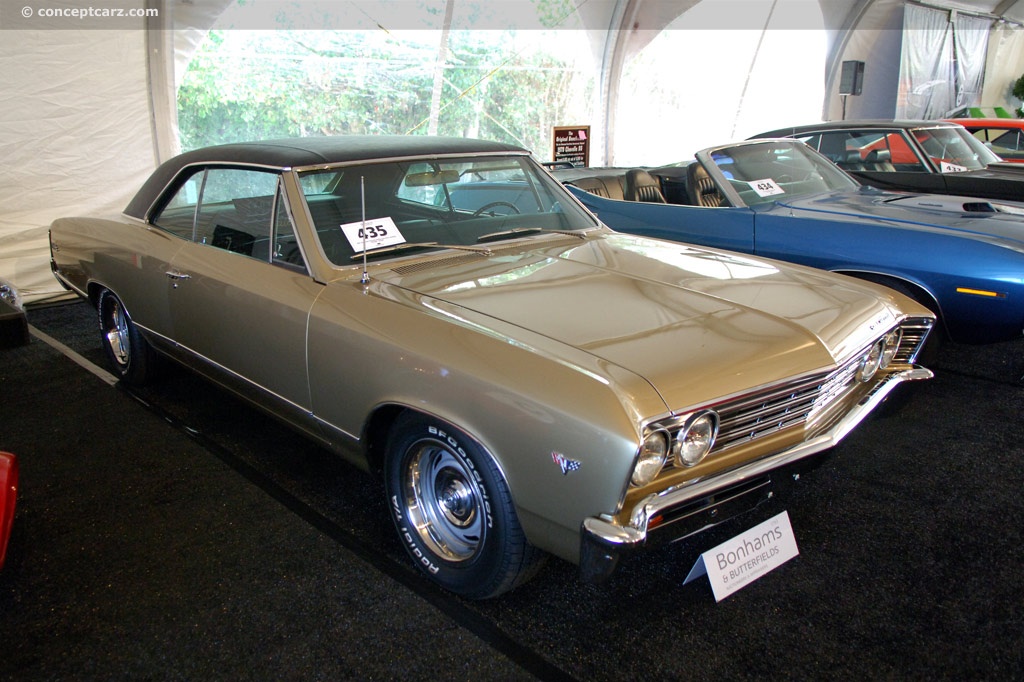
300 Series 31 6 Cyl Sedan
Chassis #: 136177Z129554
Engine #: V0215DJ
View info and history
Auction entries : 2
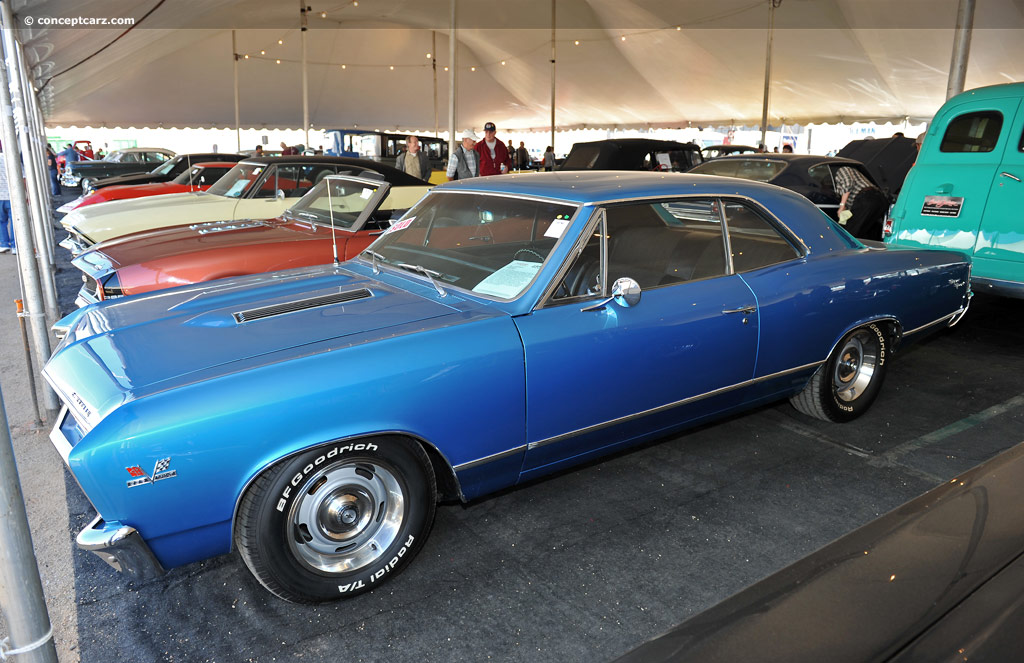
Malibu Series 36 V8 Sport Coupe
Chassis #: 136177B105633
View info and history
For 1966 the Chevelles performance-oriented Super Sport moved from being an options package to a series of its own (subseries 138), available with 396 cubic-inch big-block engine. The 'SS' had been part of the Chevelle since the beginning and represented Chevrolet's entry into the muscle car arena. Early 1964 and 1965 Chevelle Malibu SS models wore Malibu SS badging on its rear quarter panel. The Super Sport package added an additional $162 to the price of the upscale Malibu two-door hardtop and convertible body styles. It added 14-inch full-disc wheel covers, SS emblems, additional exterior trim and brightwork, vinyl bucket-seat interior, and a floor console when the optional Muncie aluminum four-speed manual or Powerglide two-speed automatic was selected in place of the standard three-speed manual. The 1966 SS396 was based on the top-line Chevelle Malibu hardtop and convertible and successfully combined neatly sculpted 'Coke Bottle' bodylines with Super Sport appearance features, resulting in one of the most desirable muscle car designs from Chevrolet of the 1960s. The SS396 series continued for 1967, gaining a mild restyling and refinements to the SS appearance package but still offered solely with big-block power. It came with a black-accented grille and blacked-out rear cove panel, special stripes, badges, simulated scoops on the domed bonnet (hood), special wheel trims, and red-stripe tires. The interiors were trimmed in vinyl with optional bucket seats, an SS-badged steering wheel for the first time, a relocated 7,000 RPM tachometer, and a black-accented instrument panel. Factory brochures officially listing just two power levels ranging from the L35 V-8 with 325 horsepower to the L34 with 350 rated horsepower, 10 fewer than in 1966. The 375 horsepower L78 V8 was not officially included in the 1967 Chevrolet marketing material, remaining as a little-known dealer-installed option with estimates placing the number of Chevelles so equipped at just over 600 units. Its 396 cubic-inch displacement was the same that powered the 1965 Corvette, however, the L78 listed at 375 horsepower while the Corvette was rated at 425 hp.
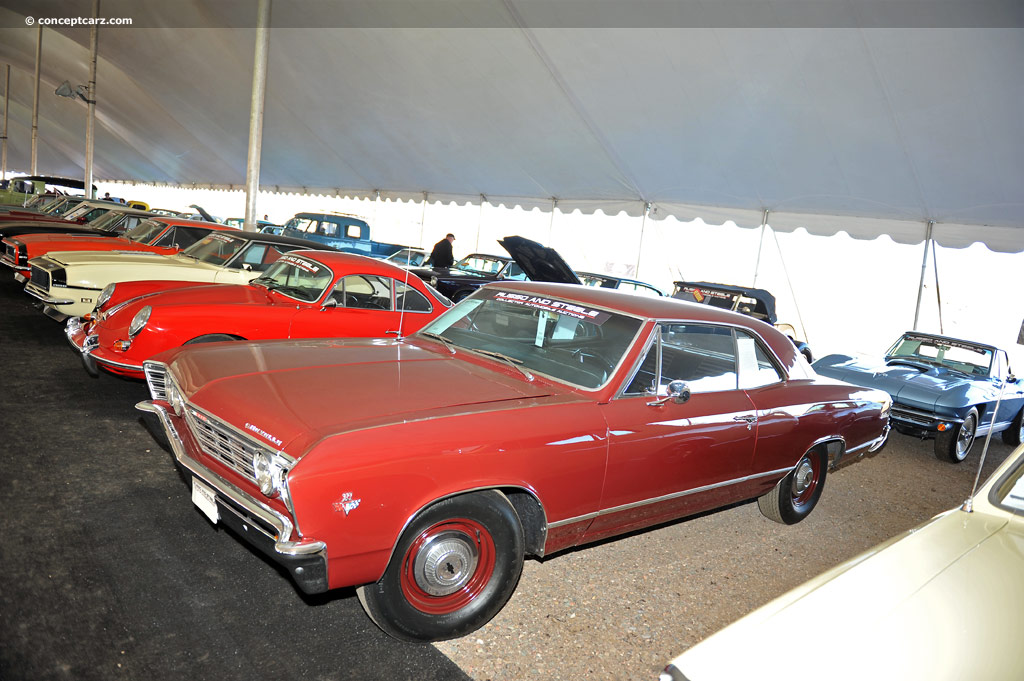
Malibu Series 36 V8 Sport Coupe
View info and history
A mild facelift followed for 1967 as Chevrolet designers and engineers prepared for an all-new generation of bodywork for 1968. The rear end styling was updated with large wraparound taillamps with standard backup lights. The anodized aluminum grille wore a slightly new design with horizontal bars that came to a point in the center. A Chevrolet badge was incorporated into the driver's-side of the grille, series identification was placed on the rear fenders, and Chevelle lettering was on the deck cove. Brightwork surrounded the windshields and ventipane frames.
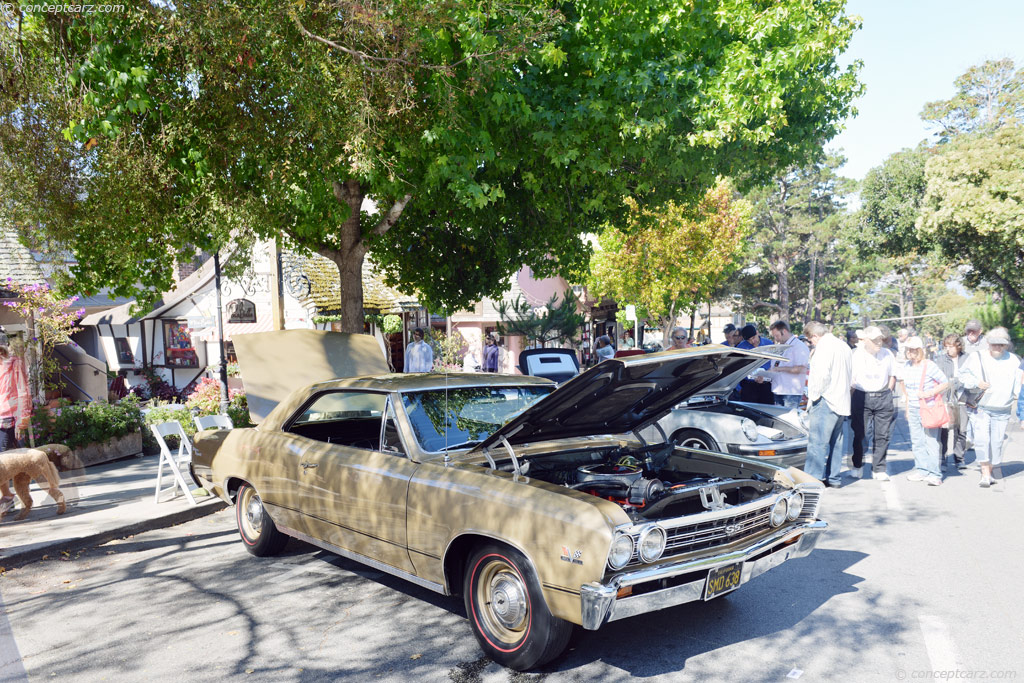
SS 396 Series 38 V8 Sport Coupe
View info and history
The Chevelle 300 Deluxe included the same body styles as the base 300 Series, plus a station wagon priced at $2,620. The sedan listed for $2,325 and the two-door sedan at nearly $2,300. The Deluxe was slightly more popular than its 300 Series sibling, with approximately 26,300 units built, less than the 37,500 examples of the 300 Deluxes produced a year earlier. There were slightly fewer Deluxes equipped with the six-cylinder engine compared to the base 300 (approximately 19,300 sixes of the Deluxe vs 19,900 of the 300). The Deluxes received additional exterior brightwork included rear cove lower-trim moldings on the sedan and body sill moldings. 300 Deluxe badging was placed on the rear fender and an emblem was positioned in the center of the tailgate. The interiors were trimmed in cloth and vinyl on the two- and four-door sedan body styles while the station wagons were all-vinyl. The instrument panel had a silver-finished upper accent, color-keyed vinyl-coated rubber floor mats, automatic interior light switches on the door jambs, and rear armrests with built-in ashtrays.1967 Chevelle Malibu
The top-of-the-line Malibu was a subseries of the mid-sized Chevelle from 1964 to 1972, and for 1967 body styles included the same list as the 300 Deluxe plus a convertible and four-door station wagon. They were distinguished from the lower Chevelle trim levels by a more lavish interior, additional exterior brightwork, and Malibu badging on the rear fender. Exterior brightwork was added to the lower bodyside, rear quarter moldings, roof drip cap moldings, and rear quarter window reveal moldings on station wagons. The wagons also had a Chevelle badge on the tailgate or rear cove, and a tailgate molding. There were full wheel covers, a black-accented rear cove outline panel, black-accented bezels around the single-unit tail lights, color-keyed floor carpeting, foam-cushioned rear seat, illuminated heater control panel, bright accents on the vinyl door panel trim, an electric clock, unique steering wheel, and a walnut-finish upper panel on the instrumentation panel. The convertible body style had courtesy lights.
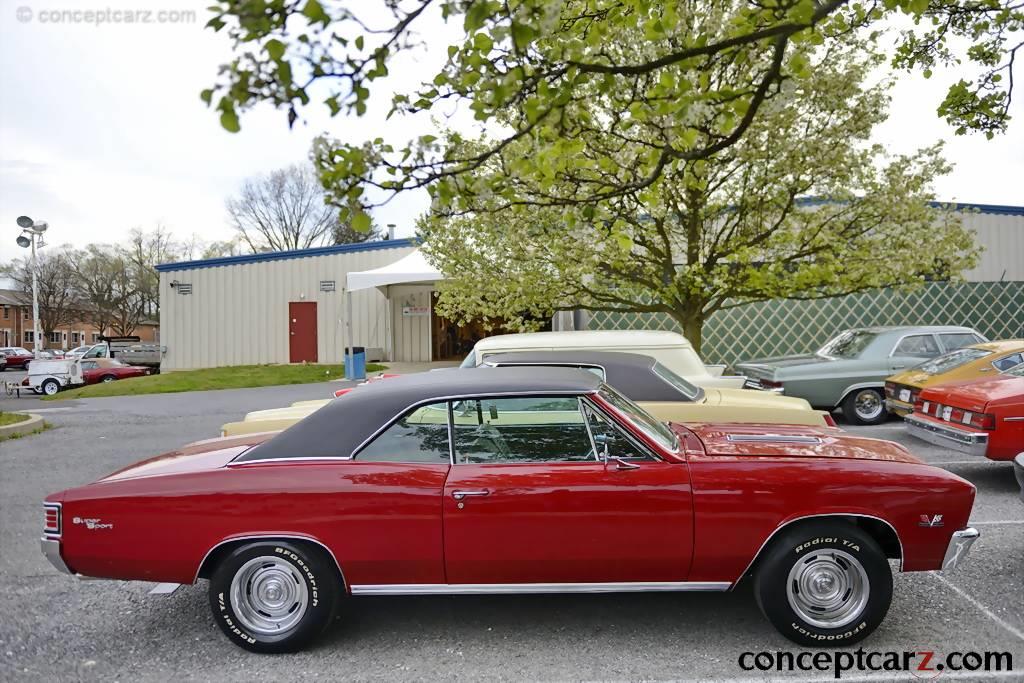
Malibu Series 36 V8 Sport Coupe
View info and history
Auction entries : 1
The Concours was offered solely as a four-door station wagon with seating for six and offered with both six- and eight-cylinder power. The six was priced at $2,830 and the base eight-cylinder option listed for $2,930. The Concours was positioned above the station wagons found within the 300 Deluxe and Malibu Series, visually distinguished by its synthetic wood grain exterior side and tailgate paneling, accented with brought outline trim. It had a unique black-accented grille, Concours identification on the rear fender, an emblem badge on the tailgate, and ribbed, gray accented body sill moldings. The rear wheelhouses also received accent moldings. The well-equipped and luxurious interior was trimmed in textured vinyl with carpeted floors and a vinyl-coated cargo load floor. Along with the passenger car sales, Chevrolet built approximately 27,300 Chevelle station wagons for 1967 with most (21,400) equipped with eight-cylinder power. These figures included the 300 Deluxe wagon, the Malibu wagon, and the Concours wagon. 1968 Chevelle
The Malibu and other Chevelles were completely restyled for 1968 with the coupes resting on a 112-inch wheelbase and the sedans and wagons on a 116-inch platform. The long-hood/short-deck profile incorporated a rounded beltline, tapered front fenders, and semi-fastback rooflines on two-door hardtops. The public agreed with the new styling and approximately 422,893 examples were built for 1968, an increase over the circa-369,106 units built the previous year.
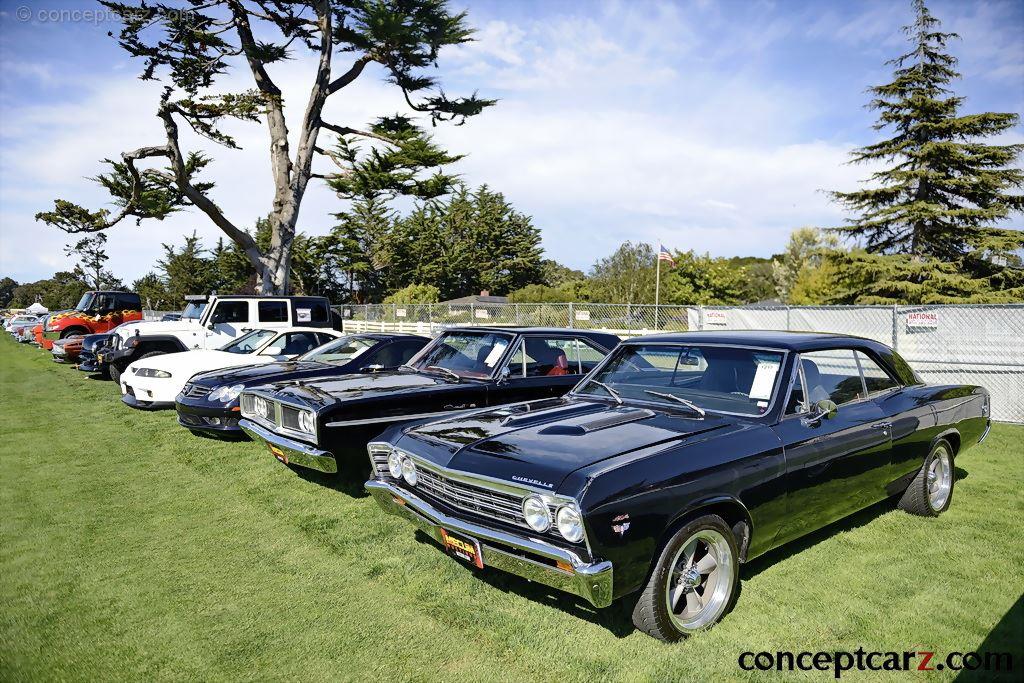
300 Series 32 V8 Two-Door Sedan
Chassis #: id38126c0l0
View info and history
Auction entries : 1
by Daniel Vaughan | Mar 2021
Related Reading : Chevrolet Chevelle History
The Chevelle was introduced on September 26, 1963, as a mid-sized vehicle for the Chevrolet fleet. It was basically a smaller version of the Impala. Muscle cars were associated with small vehicles with low weight and very few amenities but large amounts of horsepower from massive engines. The entire Detroit market had been stricken by creating faster, more vehicles. The Chevelle flirted with this....
Continue Reading >>
Continue Reading >>
Related Reading : Chevrolet Chevelle History
One of General Motors most successful vehicles, the Chevelle was a mid-sized car that was introduced in 1964 and was produced until 1977. The Chevelle models ranged from economical little family cars to commanding coupes and stunning convertibles. The Malibu was originally the top trim level in the Chevelle line which eventually replaced the Chevelle name entirely after 1977. Based on the reengineered....
Continue Reading >>
Continue Reading >>
Similarly Sized Vehicles
from 1967
Similarly Priced Vehicles
Chevrolet Monthly Sales Volume
March 2023
398,141
1967 Chevrolet Chevelle Series Vehicle Profiles
Recent Vehicle Additions
Performance and Specification Comparison
Price Comparison
$2,100 - $2,575
$2,130 - $2,545
$2,300 - $2,600
$2,400 - $2,800
$2,440 - $2,900
$2,500 - $3,310
$2,615 - $2,695
$2,700 - $3,300
$2,800 - $3,000
$3,080 - $3,400
$4,141 - $4,353
Chevelle Specification Comparison by Year
Year
Production
Wheelbase
Engine
Prices
289,860
115.00 in.
6 cyl., 194.40 CID., 120.00hp
8 cyl., 283.00 CID., 195.00hp
8 cyl., 283.00 CID., 220.00hp
8 cyl., 327.00 CID., 250.00hp
8 cyl., 327.00 CID., 300.00hp
8 cyl., 327.00 CID., 365.00hp
8 cyl., 283.00 CID., 195.00hp
8 cyl., 283.00 CID., 220.00hp
8 cyl., 327.00 CID., 250.00hp
8 cyl., 327.00 CID., 300.00hp
8 cyl., 327.00 CID., 365.00hp
$2,235 - $2,860
374,894
115.00 in.
6 cyl., 230.00 CID., 140.00hp
8 cyl., 283.00 CID., 195.00hp
8 cyl., 283.00 CID., 220.00hp
8 cyl., 327.00 CID., 250.00hp
8 cyl., 327.00 CID., 300.00hp
8 cyl., 396.00 CID., 325.00hp
8 cyl., 409.00 CID., 340.00hp
8 cyl., 409.00 CID., 400.00hp
8 cyl., 283.00 CID., 195.00hp
8 cyl., 283.00 CID., 220.00hp
8 cyl., 327.00 CID., 250.00hp
8 cyl., 327.00 CID., 300.00hp
8 cyl., 396.00 CID., 325.00hp
8 cyl., 409.00 CID., 340.00hp
8 cyl., 409.00 CID., 400.00hp
$2,100 - $4,300
72,272
115.00 in.
8 cyl., 396.00 CID., 325.00hp
8 cyl., 396.00 CID., 375.00hp
8 cyl., 396.00 CID., 375.00hp
$2,300 - $3,000
379,872
115.00 in.
6 cyl., 193.99 CID., 120.00hp
8 cyl., 283.00 CID., 195.00hp
8 cyl., 283.00 CID., 220.00hp
8 cyl., 327.00 CID., 275.00hp
8 cyl., 386.00 CID., 360.00hp
8 cyl., 396.00 CID., 375.00hp
8 cyl., 283.00 CID., 195.00hp
8 cyl., 283.00 CID., 220.00hp
8 cyl., 327.00 CID., 275.00hp
8 cyl., 386.00 CID., 360.00hp
8 cyl., 396.00 CID., 375.00hp
$2,185 - $2,965
63,006
115.00 in.
8 cyl., 327.00 CID., 325.00hp
8 cyl., 396.00 CID., 350.00hp
8 cyl., 396.00 CID., 375.00hp
8 cyl., 396.00 CID., 350.00hp
8 cyl., 396.00 CID., 375.00hp
$2,800 - $3,000
369,106
115.00 in.
6 cyl., 230.00 CID., 140.00hp
8 cyl., 263.00 CID., 195.00hp
8 cyl., 327.00 CID., 275.00hp
8 cyl., 396.00 CID., 325.00hp
8 cyl., 327.00 CID., 325.00hp
8 cyl., 396.00 CID., 350.00hp
8 cyl., 396.00 CID., 375.00hp
8 cyl., 263.00 CID., 195.00hp
8 cyl., 327.00 CID., 275.00hp
8 cyl., 396.00 CID., 325.00hp
8 cyl., 327.00 CID., 325.00hp
8 cyl., 396.00 CID., 350.00hp
8 cyl., 396.00 CID., 375.00hp
$2,200 - $3,020
Related Automotive News

Ex-Scuderia Ferrari Alfa Romeo 8C 2300 Monza Spider By Zagato Scoops Best Of Show At Salon Privé
Alfa Romeo 8C 2300 Monza Spider by Zagato raced by Tazio Nuvolari wins top award
Leading designers present inaugural Churchill Cup to rare Lancia Astura
Duke of Marlborough selects his favourites on two wheels and four
Record entry for the UKs...

1950s Sports Racing Legends Top Results as RM Sotheby's Villa Erba Sale Grosses €19.8 Million
1950s SPORTS RACING LEGENDS TOP RESULTS AS RM SOTHEBYS VILLA ERBA SALE GROSSES €19.8 MILLION
1954 FERRARI 500 MONDIAL SPIDER AND 1957 PORSCHE 550A SPYDER STEAL THE LIMELIGHT BRINGING €3,717,500 AND €3,380,000 RESPECTIVELY
RM Sothebys concl...

Sportiness In The Brand DNA: Game-Changer With Mercedes-Benz At Goodwood Festival Of Speed 2017
With a dozen racing cars and sporty vehicles from over 100 years, Mercedes-Benz Classic sums up the motto of this years Goodwood Festival of Speed Peaks of Performance – Motorsports Game-Changers celebrates competition vehicles that have written...

PEBBLE BEACH 2015: BUGATTI PRESENTS SUCCESSFUL SUPER SPORTS CARS FROM THE COMPANY'S HISTORY
The most successful racing car ever built, the Type 35, and the fastest production car in the world, the Veyron 16.4 Super Sport, are two of the record holders featured in the Bugatti line-up
Other highlights include a Type 57SC Roadster and Type 5...

120 years of motor sport at Mercedes-Benz take centre stage at the Goodwood Festival of Speed 2014
Addicted to Winning at this years Goodwood Festival of Speed, Mercedes-Benz looks back on some fascinating racing victories of the last 120 years
The unique motor sport heritage of the Mercedes-Benz brand is being celebrated with an exclusive i...



















